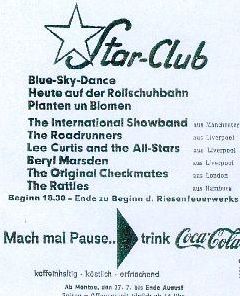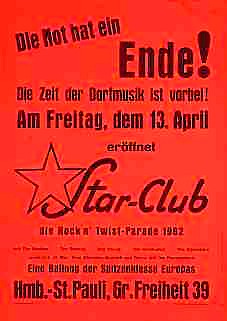We are not responsible for
links to external sites
The Roadrunners
Memories of: Hamburg
 The following is translated from a German newspaper article and includes a contribution from Frank Dostal of the Rattles. It gives a flavour of the early 60s scene in
Germany, but reflects many of the things which were also happening
in Liverpool at the time.
The following is translated from a German newspaper article and includes a contribution from Frank Dostal of the Rattles. It gives a flavour of the early 60s scene in
Germany, but reflects many of the things which were also happening
in Liverpool at the time.
It all began at the end of 1959 with the Kaiserkeller, when Bruno Koschmider opened Hamburg's first rock & roll club on the corner of Grosse Freiheit and Schmuckstrasse in the St Pauli district. Side by side with strip joints and rip-off bars, suddenly young English guys in leather jackets were standing on stage, guitars thundering, as they bellowed hot declarations of love for Lucille, Carol, Peggy Sue and Miss Molly through their 30-watt amps.
For the youth of the time - the "Teddy Boys" - this club was a revelation. There had been no rock music in Germany since Bill Haley's first tour in 1956 which saw wild street battles between fans and baton-wielding, tear-gas-throwing police. A huge press campaign had made sure that this music was almost completely suppressed. "No more of this crazy, unholy racket which doesn't deserve to be called a concert!" demanded one reader of the newspaper "Bild" after the Haley riots. And so it was.
What was left was anaemic imitators who watered down and "Germanised" the US rock originals until there was nothing left of them. Or else they had their songs written by the German popular hit makers so that it wasn't rock & roll any more but "teenager music".
Apart from that, there was only jazz. Chris Barber and Max Collie were the kings - Tiger Rag and Down By The Riverside their anthems, ringing out on every corner from jazz clubs, cellars and bars.
Rock music almost disappeared from the scene. Only a few records by Elvis, Bill Haley and Cliff Richard were officially available. Eddie Cochran or Chuck Berry fans had to go to the time and trouble of importing their singles. There was only one ray of light - the Brtish Forces Broadcasting Service and Chris Howland with his "Saturday Club" broadcast on WDR.
Against this background, the Kaiserkeller opened and became the first club in Germany to present regular live rock music.
So it was until the beginning of ེ. Tony Sheridan became a big name locally, had his first hit with Skinny Minny, and in July ཹ recorded eight tracks with the Beatles who were also booked with him at the Top Ten and occasionally backed him on stage. New groups came to take up residencies of several weeks, including Gerry and The Pacemakers and other Liverpool bands.
Nevertheless, things were in something of a rut. True, the clubs were now presenting live rock music. But the real stars, who were known from their records and the radio, didn't appear. There were only more-or-less unknown bands who played other people's hits. Even the Beatles were no exception. People could only dream of the greats - Elvis, Gene Vincent or Jerry Lee Lewis. In any case, the clubs didn't have the right facilities to bring rock music to a wider public.
With the exception of the Top Ten, all the clubs were very small. They also adopted the format favoured by the dance-cafes and usually only one band would play all week. The Star Club's time had come.
 One morning, the St Pauli
district was plastered wih
orange posters. "Your need is
at an end! The age of
bumpkin-music is over"
announced the large letters.
Then: "On Friday, 13th April,
the Star Club presents the
Rock 'n Twist Parade 1962".
One morning, the St Pauli
district was plastered wih
orange posters. "Your need is
at an end! The age of
bumpkin-music is over"
announced the large letters.
Then: "On Friday, 13th April,
the Star Club presents the
Rock 'n Twist Parade 1962".
In 1962, rock music was still an underground sub-culture, the sound of a radical minority. Even in St Pauli, where arguments were settled with fists and knives, the announcement shocked many of the youths, and their parents much more so. But a parental "No" usually has the opposite effect and, in the end, everyone came.
One of them was Frank Dostal, who at that time never dreamed that he would one day stand on the Star Club stage as singer with The Rattles.
"I went there for the first time about six months after it opened. Previously I'd only been in the Top Ten Club a few times. I'd heard that the Star Club was for rockers only and, as the rockers had a reputation for violence, I didn't go. But that all changed when I heard that the Beatles were playing there again, and I decided to chance it. It was magic. What passed for entertainment at that time was either crooners on the television or else jazz. But here were people on stage with whom I could identify - playing music which I'd only heard on records before. That really clicked with me. From then on, I went to the Star Club twice a week.
"In the eyes of my mother and other relatives, it was really dangerous to go to St Pauli so often. But actually it was cool because people could see you were going to the Star Club so they didn't try anything. You didn't wear a leather jacket or anything like that in the Star Club. Everyone wore suit, collar and tie. Anyone who wore cowboy boots as well was really progressive.
"Right from the start the Star Club was a form of counter-culture, even if we didn't realise it. The normal rules of society didn't apply."
The only problem was for those who weren't yet 18. Officially, you could go in if you were 16, but a few younger ones who either dusted off their confirmation suits or put on "lipstick, powder and paint" did manage to sneak through. But, at ten to eleven, when the star band had finished their first set, the loudspeakers announced the moment of truth to those guests who had contrived to look a couple of years older: "Ladies and gentlemen, in a few minutes it will be 11 o'clock. All those under eighteen years of age must leave the club. Please obey the instructions of the personnel. In ten minutes we will resume with..."
Soon there were almost a million visitors a year. When young people came to Hamburg, their first excursion was to the Star Club. Several even came from England, France or Scandinavia just to spend a few nights in this famed club on the Grosse Freiheit. Desperate parents wrote or 'phoned to ask whether their prodigal sons or missing daughters had been spotted. The longer the hair of the men, the more they pushed themselves towards that stage with the backdrop of the Manhattan skyline. Many of them came for years and spent their youth here experiencing the fascination of the dimly-lit hall and the bands who never stopped rocking. Here was everything for which they hungered - united in the sound which belonged only to them. The Star Club was a small taste of freedom in a hostile world which was governed by the laws and prohibitions of "The Authorities" - those who fought and wanted to suppress everything which was fun. Things like rock and beat music, sex, long hair and even being young itself.
But the Star Club was where real life was lived.